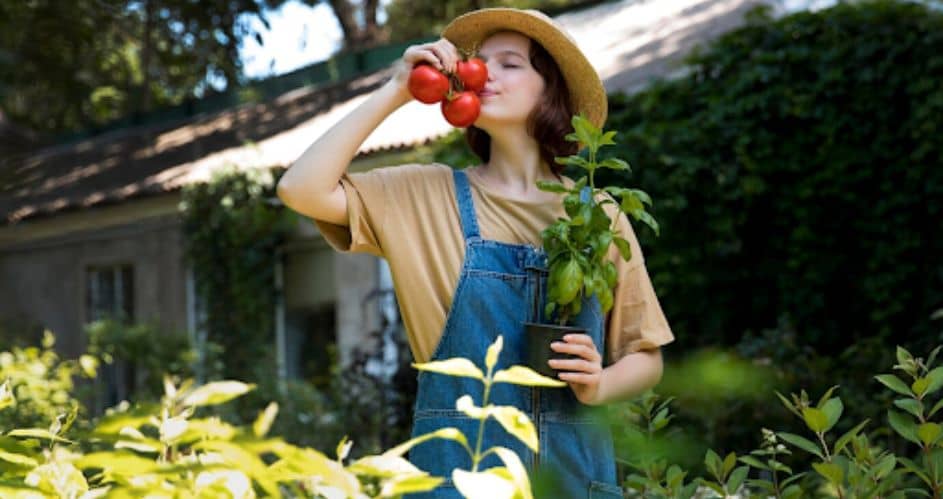
Gardening is not only about cultivating a bountiful harvest; it’s also an opportunity to create a visually stunning landscape. With a careful selection of delectable and visually stunning vegetables, watch as your garden magically transforms into an enchanting oasis.
In this article, we’ll explore a variety of vegetables that taste great and add a touch of beauty to your garden. From vibrant tomatoes to ornamental red cabbage, let’s dive into the world of visually appealing vegetables.
Tomatoes
Whether you’re in the US, the UK, or in Australia, tomatoes are a classic favorite in any garden. Plant them during the warm spring months and provide ample support as they grow. Prune the foliage regularly to maintain a neat appearance.
If you’re in Newcastle, AU, make sure to get the best newcastle topsoil for your tomatoes. Remember to water consistently and use organic pest control methods to keep unwanted insects at bay.
Carrots
Carrots may be known for their delicious crunchy roots, but their fern-like foliage adds a touch of elegance to the garden. Plant carrots in cool weather during spring or fall.
Thin them out as they grow to ensure proper spacing and promote healthy root development. Using fencing or natural repellents protects the plants from pests and unwanted animals.
Bell Peppers
If you want an eye-catching addition to your garden, consider planting bell peppers that come in a range of vibrant colors. Plant them in early summer in a sunny spot with well-draining soil.
Provide support for the plants to prevent breakage as the peppers grow. Regularly prune any damaged leaves to keep the plants looking their best.
Lettuce
As a versatile vegetable, lettuce adds beauty to your garden and provides a constant source of fresh, crisp leaves. Plant lettuce in early spring or fall, depending on your climate.
Harvest outer leaves as needed to encourage continuous growth. Protect the plants from slugs and snails by using organic slug repellents or creating barriers.
Spinach
Spinach is a delightful addition to any garden with its vibrant green leaves. Plant spinach in early spring or late summer for best results. Keep the soil moist and provide partial shade in warmer climates to prevent bolting. Regularly harvest outer leaves to promote new growth and maintain an attractive appearance.
Zucchini
Zucchini plants produce delicious squash and showcase large, beautiful leaves. Plant them in well-drained soil during the spring and ensure they receive plenty of sun. Regularly harvest the zucchini to encourage new growth and maintain a tidy garden bed.
Kohlrabi
Kohlrabi’s unique appearance makes it a standout in any garden. Plant kohlrabi in early spring or late summer. Thin out seedlings to ensure proper spacing and promote healthy bulb development. Keep the soil consistently moist and protect the plants from pests such as cabbage worms and aphids.
Herbs
You can choose to plant a variety of herbs, such as basil, rosemary, and thyme, in well-drained soil. Make sure to place them in your garden where they can get adequate sunlight.
Regularly prune the herbs to maintain their shape and encourage bushier growth. Use natural pest deterrents to protect them from unwanted visitors.
Potatoes
Potatoes may grow underground, but their lush foliage adds a touch of lushness to the garden. Plant potatoes in early spring or late summer. As the plants grow, mound soil around the stems to encourage tuber development. Regularly water and fertilize the plants to ensure healthy growth and vibrant foliage.
Red Cabbage
Red cabbage, with its deep purple color, is a stunning addition to any garden. Plant red cabbage in early spring or late summer. Provide consistent moisture to prevent splitting and ensure vibrant color. Protect the plants from cabbage worms and aphids using organic pest control methods.
Tips for Creating an Aesthetically Pleasing Vegetable Garden
To further enhance the beauty of your vegetable garden, consider the following tips:
Plan Your Layout:
Design your vegetable garden thoughtfully to create visual interest. Vary the plants’ height and consider the vegetables’ color when planning your plot. Plant taller vegetables like tomatoes and zucchini at the back and smaller ones like lettuce and herbs at the front.
Use Colorful Mulches:
Mulch not only helps to retain soil moisture and deter weeds, but certain types can also add a pop of color to your garden. Consider using straw, colored wood chips, or cocoa shells.
Create Borders:
Use flowers or herbs to create vibrant borders around your vegetable patches. Marigolds, nasturtiums, and lavender are great choices as they add color and help in pest control.
Regular Maintenance:
Keep your garden neat and tidy by pruning, watering, and removing dead or diseased plants. This helps to showcase the beauty of each plant.
Add Garden Art:
Consider adding garden art or decor, such as stepping stones, statues, or birdhouses, to lend a touch of charm and character to your vegetable garden.
Container Gardening:
Use colorful pots and containers to grow your vegetables if space is limited. They add visual appeal and can be moved around to create different looks.
Conclusion
Remember, a visually pleasing garden is one where the plants are healthy and well-cared for. Combined with these tips, regular maintenance will help you achieve a stunning vegetable garden that’s a feast for the eyes and palate.
